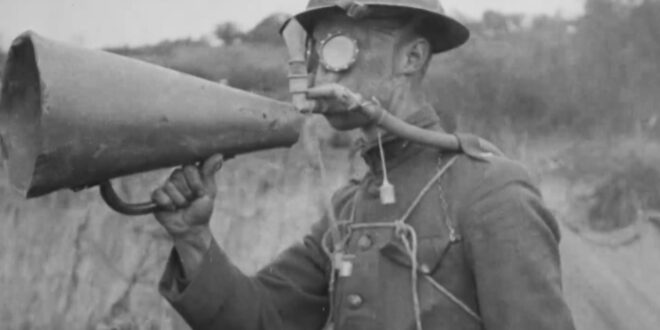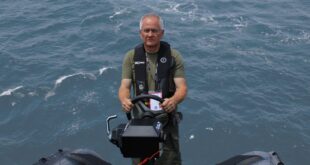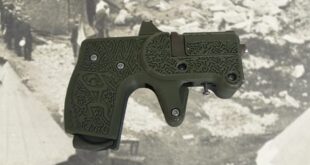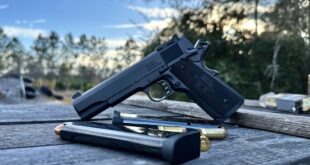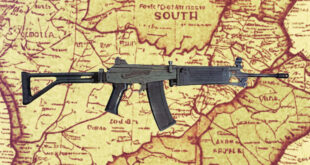Since its development during the First World War, the military gas mask has turned into the modern-day respirator. But what the steps did it take along the way?
The advent of chemical warfare saw the German army deploy chlorine gas against British soldiers at Ypres, killing more than 1,000 troops and injuring over 7,000 others on 22 April 1915.
Since that day the gas mask has become a vital part of military equipment – and is still just as crucial on the battlefield today. Here’s how the evolved in the United Kingdom.
1914-1918: The first gas masks
Following the unexpected and lethal chemical attack by the German army on the northern end of the Ypres salient, tactics against gas warfare were quickly developed and implemented.
These included practical gas masks and gas alarm equipment.
The earliest masks were simply cotton pads coated in chemicals or ventilated hoods with eyepieces. However, these were known to fog up and were easily damaged.
This design was developed into the “tube” helmet that had glass eyepieces and a rubber tube for troops to breathe through.
The “tube” helmet was eventually replaced by the Small Box Respirator mask, which was much more effective.
1939-1940: Military and civilian masks
The earliest examples of the service respirator can be traced back to the Second World War when Avon Protection began developing millions of masks for both civilian and military use.
Justin Hines, Avon Protection’s director of strategy and capability, told Forces News how the first respirator of the war was a fabric-coated rubber facemask with twin eyepieces and a forward-facing exhale valve.
He said: “The filter is connected to the mask via a hose, and you’ve got this rather bulky metal container filter.
“Carbon technology was in its infancy, and the fabric-coated rubber would be what was available at the time.”
The mask would later have synthetic materials incorporated into its design that provided all the chemical properties that were required to protect the user at the time.

A gas mask developed and issued during the Second World War by Avon
1943: The respirator
In the middle years of the war, the gas mask began to take a form that resembled the modern-day respirator.
Unlike the early designs, the filter was more compact and more accommodating for the user. Earlier models required the filter to be carried in a separate container, connected via a hose.
Mr Hines said: “The key difference is the filter. The filter is now much smaller, much more compact and because of that it is able to be attached to the mask.
“Instead of having this bulky filter that you’ve got to carry on your body somewhere, the filter is contained in a more traditional position on the face.”

A mask developed in 1943 with a smaller and more compact filter
1950: The S6 respirator
Following the Second World War, the development of the gas mask slowed down, but steps were still taken to ensure the design was improved.
The S6 model incorporated an airbag seal, which was more comfortable to wear while ensuring a good gas seal.
The masks were seen by the world when they were famously worn by the SAS team responsible for storming the Iranian Embassy in 1980.
“It was moving from a design to give you some protection to something that is designed to actually aid you doing your job,” said Mr Hines.

The S6 respirator was worn by SAS troops in Operational Nimrod as they stormed the Iranian embassy
1980: The S10 respirator
As the mask developed, both comfort and practicality became more important in the design. While the earliest examples were used strictly for protection, the S10 respirator allowed the user to drink and communicate more easily.
The S10 also had improvements made to its filter.
Mr Hines continued: “The filter in terms of diameter and thickness looks very similar to some of those earlier filters. The key differences in the technology now though with these filters is that they will protect against a much broader range of chemicals.
“The filter really hasn’t reduced significantly in size, but the level of protection that it provides, or the broadness of protection, has increased significantly.”

The British GSR (General Service Respirator) entered service in 2011
2011: British forces’ General Service Respirator
The General Service Respirator (GSR) came into service with the Armed Forces in 2011.
The mask benefits from a panoramic visor and two filters that can be changed more easily.
Lessons learned from the GSR in modern warfare will be used to shape future improvements in chemical warfare equipment.
-From British Forces Net.
 Soldier of Fortune Magazine The Journal of Professional Adventurers
Soldier of Fortune Magazine The Journal of Professional Adventurers


